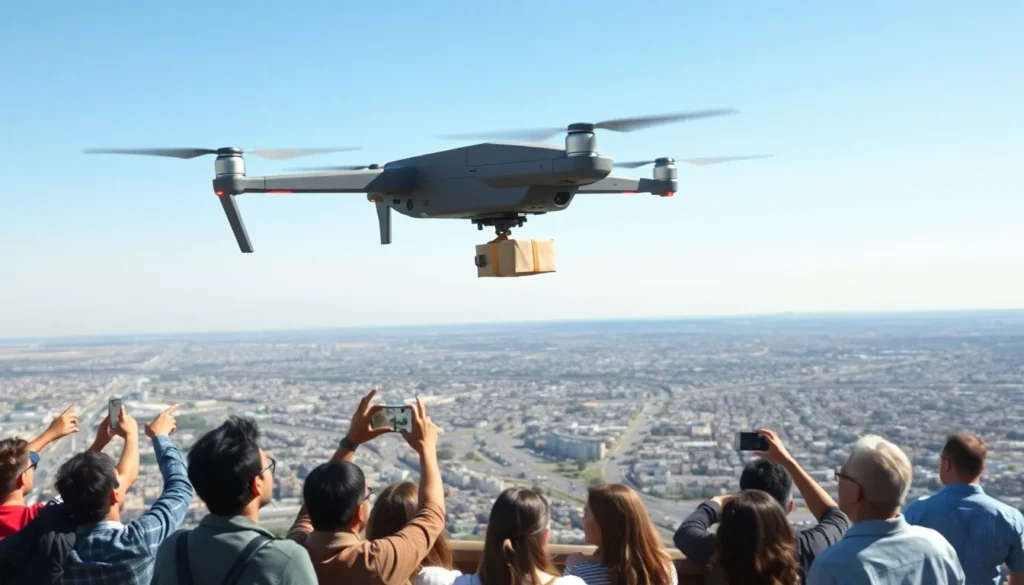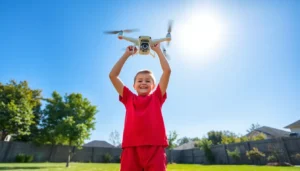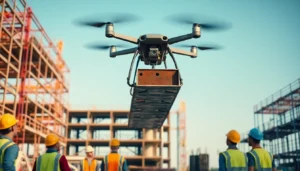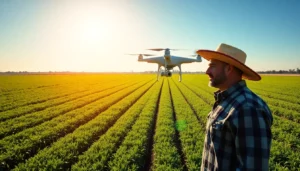Table of Contents
ToggleIn a world where getting from point A to point B can feel like a marathon, long distance drones are swooping in to save the day. Imagine sending packages, medical supplies, or even snacks across miles without the hassle of traffic jams or flight delays. These high-flying marvels aren’t just for tech enthusiasts; they’re transforming how industries operate and how people connect.
Overview Of Long Distance Drones
Long distance drones, also known as extended range unmanned aerial vehicles, play a crucial role in various sectors by facilitating remote operations. These drones can cover distances exceeding 100 miles, making them suitable for applications like delivery services, surveillance, and search and rescue missions. Industries benefit from this technology, leveraging its capabilities to enhance efficiency.
Many models are designed for specific tasks, such as cargo transport, with payload capacities ranging from 5 to 500 pounds. Advanced features include real-time tracking and autonomous flight paths, which ensure timely and secure deliveries. Additionally, the integration of AI enables drones to optimize routes based on weather and air traffic conditions.
Regulatory frameworks are evolving to accommodate long distance drone operations. The Federal Aviation Administration (FAA) has implemented guidelines that allow for beyond visual line of sight (BVLOS) operations under certain conditions. Companies can now test and deploy these drones in commercial airspace, enhancing logistics and connectivity.
Data collected by long distance drones proves invaluable for industries like agriculture and environmental monitoring. Sensors installed on these drones capture high-resolution images and gather real-time analytics, supporting decision-making processes. These insights range from crop health assessments to wildlife tracking.
Communities also gain advantages through improved access to essential services, especially in remote or underserved areas. Long distance drones reduce delivery times for medical supplies, ensuring timely assistance in emergencies. Moreover, the adoption of drone technology fosters innovation, encouraging further advancements that shape the future of transportation.
Applications Of Long Distance Drones
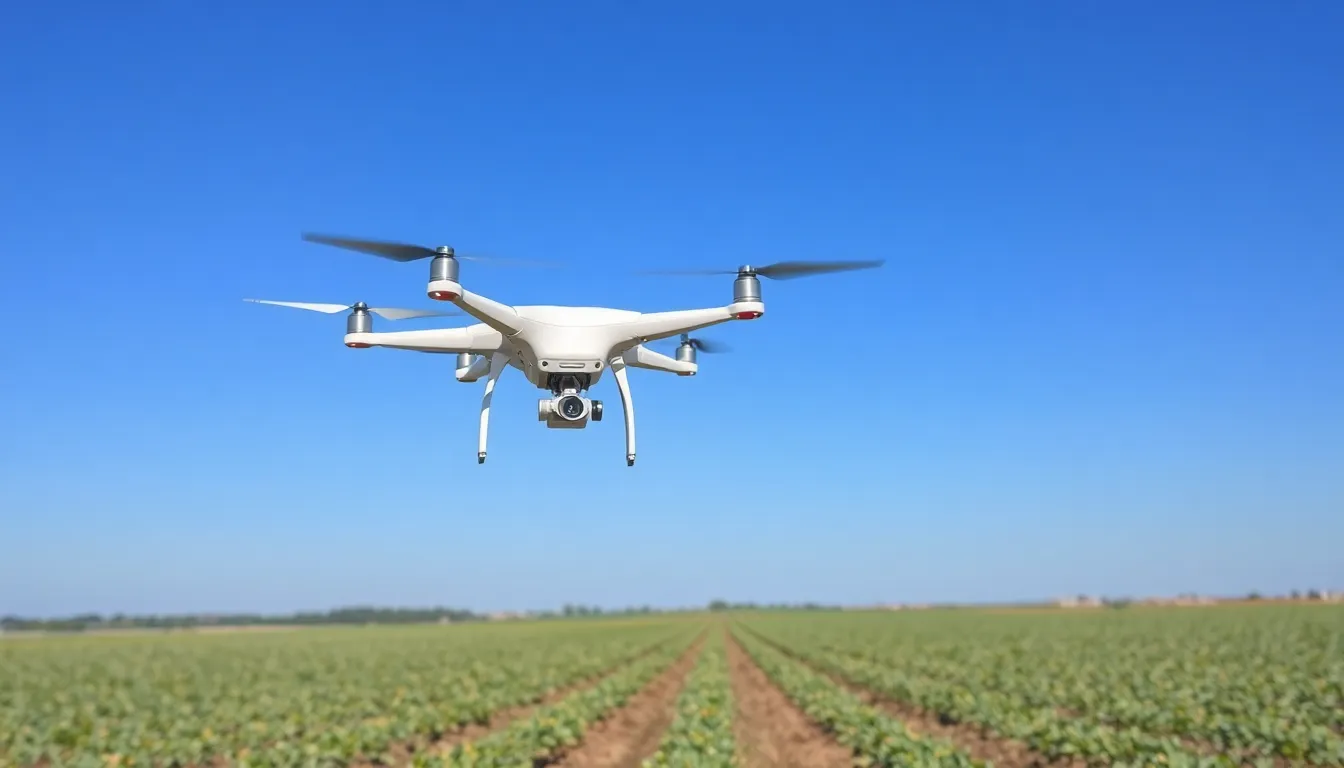
Long-distance drones find extensive applications across various industries. These advanced unmanned aerial vehicles enhance efficiency and effectiveness in critical operations.
In Logistics
Logistics benefit significantly from long-distance drones through improved delivery speed. Companies utilize these drones to transport packages swiftly over distances that exceed 100 miles. Operations become more streamlined, reducing reliance on ground transportation. Many businesses deploy drones for last-mile deliveries, cutting down delivery times from hours to minutes. Payload capacities range from 5 to 500 pounds, supporting diverse shipping requirements. Real-time tracking capabilities further enhance operational transparency, allowing customers to monitor their shipments. By optimizing routes based on weather and air traffic data, drones provide a competitive edge in logistics services.
In Agriculture
The agricultural sector leverages long-distance drones for enhanced monitoring and analysis. Drones equipped with sensors collect vital data on crop health, soil conditions, and irrigation needs. Farmers utilize this information to make informed decisions, improving yield and efficiency. Some drones can cover large fields quickly, identifying areas requiring attention. By enabling precision agriculture, these drones reduce resource waste and increase productivity. Additionally, aerial surveys provide farmers with insights into pest and disease management. Overall, long-distance drones revolutionize traditional farming practices, promoting sustainability and maximizing crop outputs.
In Surveillance
Surveillance applications of long-distance drones enhance security measures across various domains. Law enforcement agencies employ these drones for monitoring large areas during events or emergencies. Capable of flying beyond the operator’s visual line of sight, they offer a strategic advantage in crowd control and situational awareness. Private security firms also use drones for property monitoring, ensuring quick response to security breaches. With high-resolution cameras and thermal imaging, long-distance drones provide comprehensive surveillance solutions. Their ability to cover extensive distances ensures thorough monitoring of hard-to-reach locations, delivering peace of mind to communities and businesses alike.
Technological Advancements
Ongoing developments in long-distance drones showcase significant enhancements in performance and usability. These advancements focus on areas such as battery life and communication systems, critical for maximizing efficiency.
Battery Life Improvements
Drones benefit from recent battery technology innovations. Lithium-sulfur batteries, for example, offer higher energy density compared to traditional lithium-ion options. This boost enables drones to fly longer distances without frequent recharging. Flight times for many models can exceed 10 hours, allowing operations across vast areas. Enhanced battery management systems also contribute by optimizing power usage during missions. As a result, these improvements support extended missions for deliveries in remote locations and offer better reliability in various weather conditions.
Communication Systems
Advanced communication systems improve connectivity for long-distance drones. The integration of 5G technology facilitates real-time data transmission, which enhances operational control. High-frequency bands reduce latency, allowing for quicker response times during complex missions. Drones equipped with satellite communication systems provide coverage even in areas devoid of cellular networks. These robust systems enable seamless collaboration between multiple drones, ensuring efficient task execution in logistics, surveillance, and emergency response. Enhanced communication capabilities ultimately expand the operational range and functionality of long-distance drones across industries.
Challenges Facing Long Distance Drones
Long-distance drones face several challenges that impact their efficiency and deployment in various applications. Key difficulties include regulatory hurdles and technical limitations.
Regulatory Hurdles
Regulatory frameworks pose significant barriers for long-distance drone operations. Strict guidelines established by the Federal Aviation Administration (FAA) impact flight permissions, particularly for beyond visual line of sight (BVLOS) operations. Compliance with these regulations demands rigorous testing and approval processes. Approval for commercial use often remains slow, delaying innovation in the industry. Different states may impose additional laws, complicating cross-border operations. Companies must navigate varying regulatory landscapes to ensure efficient deployment. Meeting all requirements involves time and significant resources, hindering the overall growth of the long-distance drone market.
Technical Limitations
Technical challenges also hinder the advancement of long-distance drones. Battery life remains a critical issue, as many drones struggle to maintain extended flight times without frequent recharging. These limitations impede prolonged operations, particularly in remote areas. Communication systems often face vulnerabilities due to distance, resulting in potential data loss or transmission delays. Reliability can decrease in harsh weather conditions, affecting operational capabilities. Additional technical obstacles include payload limitations, which restrict the amount of cargo that can be transported efficiently over long distances. Addressing these technical shortcomings is essential for maximizing the effectiveness of long-distance drone technologies.
Future Trends In Long Distance Drones
Emerging technologies show promise for long-distance drones, particularly in efficiency and versatility. Battery innovations like lithium-sulfur batteries significantly extend flight durations, allowing drones to operate for over 10 hours. Advanced aerodynamics contribute to improved fuel efficiency, enabling these aircraft to travel farther without frequent recharges.
The integration of artificial intelligence enhances navigation capabilities, ensuring drones can adapt routes in real-time based on changing weather or air traffic conditions. The combination of AI and machine learning equips drones with predictive analytics, optimizing delivery schedules and minimizing delays.
5G technology and satellite communication systems improve connectivity, facilitating seamless data sharing between drones and operators. Enhanced transmission speeds enable high-resolution imaging and live video feeds, making drones more effective for surveillance and monitoring operations.
Regulatory changes are aligning with technological advancements, allowing wider testing and deployment of long-distance drones. Governments are adapting policies to promote innovation, particularly in BVLOS operations. The establishment of drone corridors is a potential change that supports safe and efficient airspace usage.
Sustainability is becoming a focal point in the development of long-distance drones. Companies are exploring eco-friendly materials and energy-efficient designs to minimize environmental impact. Solar-powered drones represent a growing segment within this trend, providing a renewable energy solution that extends operational capabilities.
New applications continuously emerge as industries leverage long-distance drones for diverse tasks. Healthcare organizations utilize drones for rapid delivery of medical supplies, significantly reducing response times in emergencies. In agriculture, farmers increasingly rely on drones to gather data, enhancing precision farming techniques.
Long-distance drones are positioned to revolutionize various sectors in the future. As advancements continue, the potential for increased operational efficiency and broadened applications remains substantial.
Long-distance drones are reshaping the landscape of transportation and logistics. Their ability to deliver essential goods swiftly and efficiently is transforming industries and enhancing connectivity. As technology advances and regulatory frameworks adapt, these drones are set to unlock even greater potential.
With innovations in battery life and communication systems, long-distance drones are becoming more reliable for various applications. The future looks promising as they continue to evolve, offering solutions that address both operational challenges and sustainability concerns. As industries embrace these advancements, long-distance drones will play a vital role in shaping the future of transportation and service delivery.

